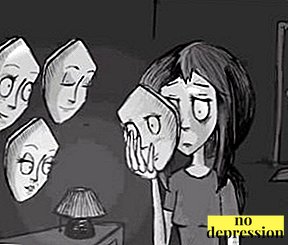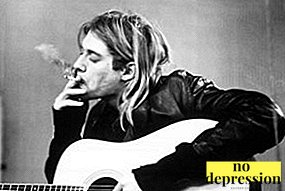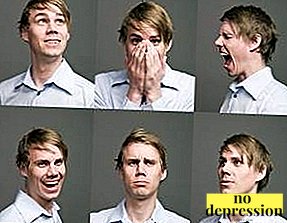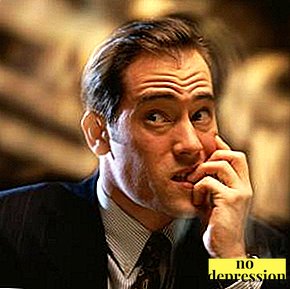 Stages of depression: why allocate them?
Stages of depression: why allocate them?
Depression changes over time. The patient’s condition and symptoms may vary over time. If you do not take any measures, the patient’s condition may worsen every day - until, finally, the problems are insurmountable and not subject to solution.
That is why it is important to determine the specific condition of the patient now - the treatment plan will depend on it. Psychologists and psychiatrists divide the development of depression into several stages - stages by which symptoms develop. Our site has prepared for you the 2 most popular approaches to determining the stages of depression:
Approaches to determining the stages of depression
It should be remembered that psychology is a relatively young science and not yet accurate. Therefore, the division of the state of depression into stages varies in different psychological schools. In particular, Russian psychology traditionally distinguishes three stages:
- rejecting
- host
- rodent
Sometimes the fourth stage is additionally distinguished. For her, there is no universally accepted name, but most often it is called the final one. At this stage, the symptoms of depression are exacerbated so much that the risk of suicide increases many times, the personality begins to disintegrate, and treatment is possible only in the hospital, and the psychological problem clearly becomes psychiatric. As a rule, this stage occurs in cases where depression is only a symptom of more serious mental illness.
In addition to the three-stage division, in the popular psychological literature the classification of depression stages of the following type is common:
- negation
- offense
- bargain
- depressive disorder
- taking and getting out of depression
It is easy to see that this classification concerns mostly less severe cases of depression. If it is one of the symptoms of other mental illnesses (for example, schizophrenia, bipolar affective disorder, etc.) - there is no hope that the patient will enter the stage of acceptance on his own. In this case, it helps only for psychiatric care and drug therapy. We advise you to read our article.
The main classification of the stages of depression
In the case when the three-step division of the patient's condition is used, the following stages of the course of depression are distinguished.
Rejection stage
In this case, the person with all his strength drives away the thought that he is depressed. He justifies his condition by any available means: “I’m tired, I’ll have another day to rest - and I’ll be as good as new!”, “The weather is bad, and everything falls out of my hands ...”, “I don’t get enough sleep; etc. This stage is characterized by apathy, lethargy, lack of desire to act. The patient has no appetite, he is haunted by drowsiness - or, on the contrary, there are sleep disturbances (insomnia, inability to fall asleep without sleeping pills or alcohol).
In essence, a person is trying with all his might to escape from his state and the problems that haunt him. As depression develops, anxiety increases, drowsiness either increases, or, conversely, insomnia increases. A person gradually loses interest in work, in hobbies, he has a pile of unfinished business. At work, he, as a rule, begins to make mistakes - initially small, but each time more and more serious.
Attempts to solve mental problems with the help of alcohol at this stage are extremely dangerous and can only lead to alcohol dependence. The fact is that although alcohol is a psychoactive substance (surfactant), it acts as an overwhelming agent, an additional depressant. Its use only exacerbates the problem. The same applies to smoking: nicotine acts only as "stunning." The smoker relieves the symptoms for a while - but, first, then they return in a magnified manner. Secondly, smoking has too many side effects (ranging from the harmful effects on the cardiovascular system, ending with a carcinogenic effect) so that it can be seriously recommended.
Host stage
The patient is aware of his condition. At the same time, somatic changes occur simultaneously with psychological ones (in particular, the production of the hormone serotonin decreases or stops). Appetite decreases (up to the complete disappearance of the feeling of hunger), body weight decreases. Existing chronic diseases are exacerbated. In essence, this means that the body "declares surrender" and goes into an autonomous mode of struggle with itself. Sleep disturbances turn into protracted insomnia, when for several days the patient experiences drowsiness — he either cannot fall asleep, or the “fast sleep” phase does not occur, and there is no complete rest at night.
Violations of logical thinking begin, the appearance of hallucinations ("voices in the head", etc.) is possible. Thoughts about suicide, which have arisen before, are intensifying and may become obsessive. Speech becomes abrupt, replicas are not connected to each other (it is extremely difficult for a person to keep a logical chain in the head). The attention is reduced to a minimum, the patient is almost impossible to complete at least some business. Behavior can become unrestrained and vulgar, a person is capable of aggressive attacks on others without a reason.
At this stage, as a rule, one cannot do without the help of specialists. If the first may still have enough mild sedatives (preparations based on Hypericum or Valerian), then synthetic antidepressants and the help of a psychologist may be required. By the way, it was at this stage that V. Mayakovsky wrote his famous verse "Instead of writing (To Lilichka)". Then he climbed out of depression - but the addiction remained. What is curious, Mayakovsky kept his word: he wrote that “I couldn’t press the trigger over the temple” - it happened. After 14 years, he shot himself not in the temple, but in the heart.
Corrosive Stage
It is extremely dangerous because the disorder enters the preterminal stage. Vital functions of the body are preserved, but in general it goes into "autonomous mode". Pathologies are clearly manifested in the psyche: on the one hand, the patient is detached from the world, indifferent to those around him, and on the other hand, aggression and auto-aggression (up to self-healing) are increasingly manifested in his behavior. There is a disassociation with the individual. Problems with logic reach the limit, a person is unable to finish any of the cases. The patient feels his existence as meaningless, lives, in fact, only by habit. There are problems with memory, with self-control, with priorities - a spontaneous thought or desire can immediately turn into action. The patient can harm others: as he himself believes, he “has nothing to lose but the deadly sense of ultimate guilt” (by the way, the text of S. Kalugin’s song “The Rising of the Black Moon” very well conveys the patient’s self-awareness at this stage).
If it came to this stage, the person urgently needed the help of a psychiatrist, sedatives and anti-depressants. Independently from this stage, as a rule, are not selected. Exceptions are extremely rare.
Terminal stage
The terminal stage of depression, allocated additionally. This is the finale of the rodent stage. Complete disintegration of the personality, the maximum threat of suicide. In particular, the case that went into all psychiatry textbooks occurred with a patient at this particular stage of depression: the patient managed to commit suicide right in front of the attendant with a blunt pencil. The patient was lying on the bed, covered with a blanket - and under it quietly managed to drill a hole in his chest between the ribs and stick it in his heart. The orderly only remembered when the patient turned pale and stopped breathing. In fact, at this stage, the personality has already ended - there is only a biological object, seeking to self-destruct.
The prospects for treatment at this stage are negative. In fact, there is no chance that the patient will fully recover. Even if he remains alive, he is waiting for a deep disability. Therefore, it is extremely important to start treatment at earlier stages.
Alternative Depression Classification
In addition to the above, another division of depression into stages is used. In this case, the following stages of depression are distinguished:
Negation
As in the previous classification, at this stage the patient rejects his illness, even he does not admit to himself that problems started with the psyche. The general rhythm of life is maintained, however, there is a decrease in vitality, sleep disturbance (in the form of insomnia or constant sleepiness). The behavior is characterized by epatage and demonstrativeness: a person, although he does not recognize his depression, is struggling with it - and, in fact, appeals to others: "Pay attention to me, help me!".
Offense
The patient is looking for someone to blame for what is happening to him. If he himself is found guilty, problems with self-esteem begin. Bursts of rage, aggressive behavior, bitterness are possible.
Bargain
Reserves are spent, the person is trying to negotiate - with the universe, with God, with the world. Thoughts are typical: "Ok, I will do everything, just return everything as it was ...", "Please fulfill my request ..." and so on.
 Depressive disorder. Fracture
Depressive disorder. Fracture
Bargaining was useless - and despair, self-pity, binges, mindless destruction of food and other symptoms of depression begin. The risk of alcoholism, anesthesia, suicide - the maximum.
It was at this stage that the famous musician Kurt Cobain committed suicide. Depression, complicated by heroin addiction, led to the fact that Cobain felt his own uselessness, lost the ability to feel the pleasure of music, the blame for loved ones and fans - and it ended with a shot from the gun to the head on April 5, 1994. Characteristically, the symptoms of depression Kurt showed from the beginning of the year: his wife Courtney Love, and the musicians of the Nirvana group, and other acquaintances noted that Cobain was "quiet," "estranged from the relationship," and so forth. Perhaps timely psychiatric care could save Cobain's life.
Adoption
A person resigns himself to depression, accepts himself as he is.
In the treatment of depression, motor activity is restored first - but thinking remains rigid and inhibited. And this combination of complete ability to move with thinking disorders is extremely dangerous. It is at this stage of treatment that suicides often occur.
Conclusion
Determining the stage of depression is extremely important in order to select the necessary measures for treatment. Despite the fact that different psychological schools differently determine how to categorize these stages - they mostly converge. And only timely measures can help a person suffering from depression recover.

 Stages of depression: why allocate them?
Stages of depression: why allocate them? Depressive disorder. Fracture
Depressive disorder. Fracture

